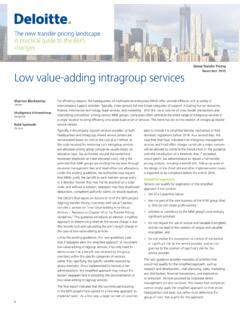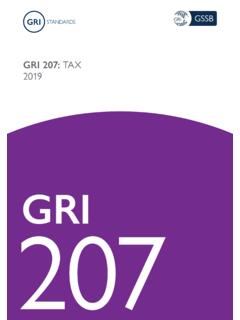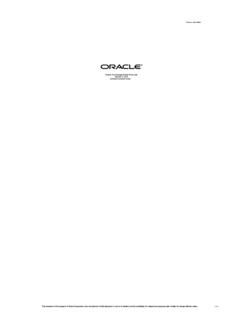Transcription of Brochure: Two-Pillar Solution to Address the Tax ...
1 OECD/G20 Base Erosion and Profit Shifting Project Two-Pillar Solution to Address the Tax Challenges Arising from the Digitalisation of the EconomyOCTOBER 2021 CONTENTSI ntroduction3 Statement on a Two-Pillar Solution to Address the Tax Challenges Arising from the Digitalisation of the Economy 6 Detailed Implementation Plan10 Background12 What are the problems with the old international tax rules? 13 What is the Two-Pillar Solution ? 14 What will the impact be? 16 Next steps16 Key milestones17 Frequently asked questions18 References21 This document is published under the responsibility of the Secretary-General of the OECD. The opinions expressed and arguments employed herein do not necessarily reflect the official views of OECD member countries or of members of the OECD/G20 Inclusive Framework on BEPS.
2 This document, as well as any data and any map included herein, are without prejudice to the status of or sovereignty over any territory, to the delimitation of international frontiers and boundaries and to the name of any territory, city or area. OECD 2021 The use of this work, whether digital or print, is governed by the Terms and Conditions to be found at images OECD 2021 INTRODUCTION | 3 IntroductionFollowing years of detailed and intensive work and negotiations to bring the international tax rules into the 21st century, members of the OECD/G20 Inclusive Framework on BEPS (the Inclusive Framework) agreed on 8 October to the Statement on the Two-Pillar Solution to Address the Tax Challenges Arising from the Digitalisation of the Economy.
3 The Two-Pillar Solution will ensure that multinational enterprises (MNEs) will be subject to a minimum tax rate of 15%, and will re-allocate profit of the largest and most profitable MNEs to countries and globalisation have had a profound impact on economies and the lives of people around the world, and this impact has only accelerated in the 21st century. These changes have brought with them challenges to the rules for taxing international business income, which have prevailed for more than a hundred years and resulted in MNEs not paying their fair share of tax despite the huge profits many of these businesses have garnered as the world has become increasingly interconnected. In 2013, the OECD ramped up efforts to Address these challenges in response to growing public and political concerns about tax avoidance by large multinationals.
4 Implementation of the 15 Actions of the BEPS package agreed in 2015 is well underway, but gaps remain. The current rules still allow large multinationals to earn significant income in a jurisdiction without paying corporate income tax there. New business models that rely heavily on intellectual property have made it easier for MNEs to shift profits to low-tax jurisdictions. Globalisation has exacerbated unhealthy tax competition. Now, 136 countries and jurisdictions, representing more than 90% of global GDP, have joined the Two-Pillar Solution establishing a new framework for international tax and agreed a Detailed Implementation Plan that envisages implementation of the new rules by 2023. A small number of the Inclusive Framework s 140 members have not yet joined the Two-Pillar Solution at this | Two-Pillar Solution TO Address THE TAX CHALLENGES ARISING FROM THE DIGITALISATION OF THE ECONOMY OECD 2021 The Two-Pillar Solution is comprised of Pillar One and Pillar Two.
5 Pillar One aims to ensure a fairer distribution of profits and taxing rights among countries with respect to the largest MNEs, which are the winners of globalisation. Tax certainty is a key aspect of the new rules, which include a mandatory and binding dispute resolution process for Pillar One but with the caveat that developing countries will be able to benefit from an elective mechanism in certain cases, ensuring that the rules are not too onerous for low-capacity countries. The agreement to re-allocate profit under Pillar One includes the removal and standstill of Digital Services Taxes (DST) and other relevant, similar measures, bringing an end to trade tensions resulting from the instability of the international tax system. It will also provide a simplified and streamlined approach to the application of the arm s length principle in specific circumstances, with a particular focus on the needs of low capacity countries.
6 Pillar Two puts a floor on tax competition on corporate income tax through the introduction of a global minimum corporate tax at a rate of 15% that countries can use to protect their tax bases (the GloBE rules). Pillar Two does not eliminate tax competition, but it does set multilaterally agreed limitations on it. Tax incentives provided to spur substantial economic activity will be accomodated through a carve-out. Pillar Two also protects the right of developing countries to tax certain base-eroding payments (like interest and royalties) when they are not taxed up to the minimum rate of 9%, through a Subject to tax rule (STTR). KEY ELEMENTS OF THE Two-Pillar SOLUTIONP illar OnePillar TwoTaxing rights over 25% of the residual profit of the largest and most profitable MNEs would be re-allocated to the jurisdictions where the customers and users of those MNEs are locatedGloBE rules provide a global minimum tax of 15% on all MNEs with annual revenue over 750 million eurosTax certainty through mandatory and binding dispute resolution, with an elective regime to accommodate certain low-capacity countries Requirement for all jurisdictions that apply a nominal corporate income tax rate below 9% to interest.
7 Royalties and a defined set of other payments to implement the Subject to Tax Rule into their bilateral treaties with developing Inclusive Framework members when requested to, so that their tax treaties cannot be abused. Removal and standstill of Digital Services Taxes and other relevant, similar measuresCarve-out to accommodate tax incentives for substantial business activitiesThe establishment of a simplified and streamlined approach to the application of the arm s length principle in specific circumstances, with a particular focus on the needs of low capacity countries. Benefits to developing countriesDeveloping countries make up a large part of the Inclusive Framework s membership and their voices have been active and effective throughout the negotiations.
8 The OECD estimates that on average, low-, middle- and high-income countries would all experience revenue gains as a result of Pillar One, but these gains would be expected to be larger (as a share of current corporate income tax revenues) among low income jurisdictions. Overall, the GloBE rules will relieve pressure on developing countries to provide excessively generous tax incentives to attract foreign investment; while at the same time, INTRODUCTION | 5there will be carve outs for activities with real substance. Specific benefits aimed at developing countries include:l the Subject to tax rule (STTR), which prevents companies from avoiding tax on their profit earned in developing countries by making deductible payments such as interest or royalties that benefit from reduced withholding tax rates under tax treaties and which are not taxed (or taxed at a low rate) under the tax laws in the treaty partner; this will help developing countries protect their treaty networks from abuse through profit shifting to low tax jurisdictions.
9 L the simplified and streamlined approach to the application of the arm s length principle to in-country baseline marketing and distribution activities, as low capacity countries often struggle to administer transfer - pricing rules and will benefit from a formulaic approach in those cases. l a lower threshold for determining the re-allocation of profit under Pillar One to smaller economies. The OECD will provide bespoke technical assistance to support all aspects of implementation of the Two-Pillar impactUnder Pillar One, taxing rights on more than USD 125 billion of profit are expected to be reallocated to market jurisdictions each year. With respect to Pillar Two, the global minimum tax rate of 15% is estimated to generate around USD 150 billion in new tax revenues globally per year.
10 Additional benefits will arise from the stabilisation of the international tax system and the increased tax certainty for taxpayers and tax implementationA Detailed Implementation Plan was also agreed. It contains ambitious deadlines to complete work on the rules and instruments needed to bring the Two-Pillar Solution into effect by 2023. OECD 2021 TARGET DEADLINESP illar OnePillar TwoEarly 2022 Text of a Multilateral Convention (MLC) and Explanatory Statement to implement Amount A of Pillar OneNovember 2021 Model rules to define scope and mechanics for the GloBE rules Early 2022 Model rules for domestic legislation necessary for the implementation of Pillar OneNovember 2021 Model treaty provision to give effect to the subject to tax ruleMid 2022 High-level signing ceremony for the Multilateral ConventionMid 2022 Multilateral Instrument (MLI)














